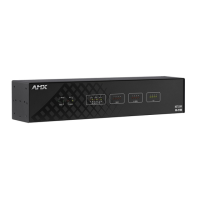
Do you have a question about the AMX NI-700 and is the answer not in the manual?
| Brand | AMX |
|---|---|
| Model | NI-700 |
| Category | Controller |
| Language | English |
Details on various NetLinx Integrated Controller models and their features.
Information on Enova DVX models and their relation to NI controllers.
General steps for initial installation, configuration, and communication setup.
Utilizing zero-configuration for quick device installation on networks.
Describes using NetLinx Studio for initial controller configuration.
Prerequisites and verification steps before starting initial configuration.
Steps to establish serial communication using NetLinx Studio and a program port.
General process for upgrading firmware on NI Controllers and Enova DVX.
Details on required firmware files for NI Master and Device Controllers.
Details on required firmware files for Enova DVX controllers.
Firmware files for NI Master and Device Controllers.
Introduction to the Master Configuration Manager and its primary sections.
Steps to connect to the Master's WebConsole via a web browser.
Understanding the three levels of security configuration: System, Group, and User.
Default security settings for accounts, groups, and access rights.
Configuring global security settings that affect the entire system.
Details on system-level security settings for access control.
Setting up ICSP connectivity when using LDAP for authentication.
Saving configuration changes made on the LDAP options page.
Procedure for creating a new user group and assigning access rights.
Examining the security access rights assigned to a specific user group.
Procedure for creating a new user account and assigning access rights.
Viewing and managing G4 Web Control touch panel connections.
Settings for using compression to decrease response delay.
Accessing and configuring various aspects of the NetLinx System.
Managing system settings including system number and reboot.
Viewing and changing the Master's system number.
Manipulating device channels, levels, and sending commands/strings.
Enabling and monitoring various diagnostic messages for system devices.
Modifying server settings and port assignments for various services.
Details on port values for Telnet, ICSP, HTTP, HTTPS/SSL, SSH, and FTP.
Describes the fields for creating an SSL certificate, including bit length and common name.
Setting the Clock Manager Mode to Network Time or Stand Alone.
Configuring Daylight Savings rules, including offset and start/end times.
Connecting to specific NIST time servers for accurate time synchronization.
Selecting the time synchronization method for the clock manager.
Information on connected NetLinx devices, their status, and firmware versions.
Viewing and configuring options for additional system devices.
Specifying how the Master manages bound devices, including auto-binding.
Copying selected modules to your PC for backup.
Removing selected modules from the Master's unbound directory.
Configuring application-defined Duet virtual devices with physical devices.
Procedure to add and define new devices manually.
Initiating a search for compatible Duet Modules for a specific device.
Enabling/disabling the Zero-Configuration client for network discovery.
Enabling/disabling NetLinx Discovery Protocol beacons for device discovery.
Adding URLs to the Master's list for device management.
Introduction to Send_Commands, Send_Strings, and Channel commands.
Table detailing port assignments for different NetLinx Master models.
Commands for configuring RS-232, 422, and 485 serial communication parameters.
Commands for generating control signals for external equipment via IR/Serial.
Types of terminal communications available on NetLinx Integrated Controllers.
Steps to connect via Program Port (RS232) or Telnet (TCP/IP).
List and descriptions of commands available in terminal sessions.
Commands for navigating and configuring security settings via the terminal.
Options for managing user accounts, passwords, and access rights.
Options for managing group accounts, directory associations, and access rights.
Procedure to add a group and configure directory associations.
Anomalies observed when using Windows Telnet/Terminal clients.
Anomalies observed when using Linux Telnet clients.
Understanding LDAP requirements and assumptions for AMX clients.
Step-by-step breakdown of the LDAP authentication process.
Introduction to NetLinx Master's built-in SMTP support for sending emails.
Specifying SMTP server properties for outbound email transmission.
Details on types and constants used by the Clock Manager API.
List and descriptions of NetLinx library calls for Clock Manager functions.